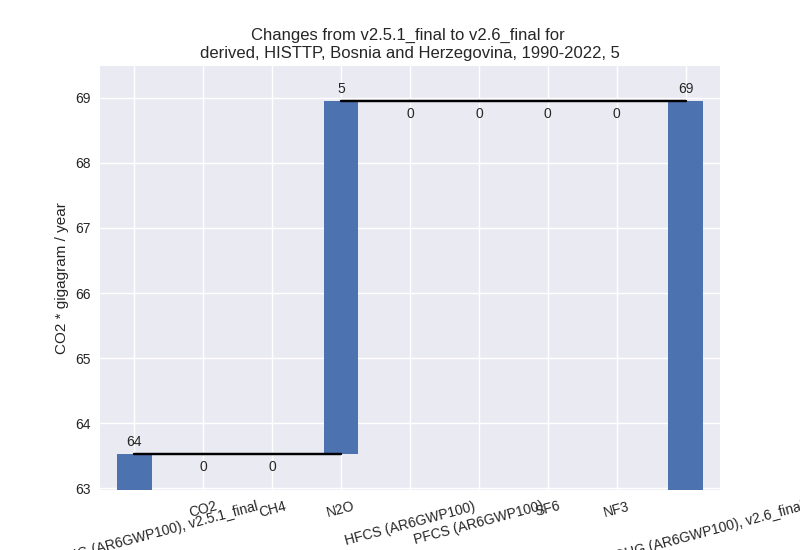Changes in PRIMAP-hist v2.6_final compared to v2.5.1_final for Bosnia and Herzegovina
2024-09-24
Johannes Gütschow
Change analysis for Bosnia and Herzegovina for PRIMAP-hist v2.6_final compared to v2.5.1_final
Overview over emissions by sector and gas
The following figures show the aggregate national total emissions excluding LULUCF AR6GWP100 for the country reported priority scenario. The dotted linesshow the v2.5.1_final data.
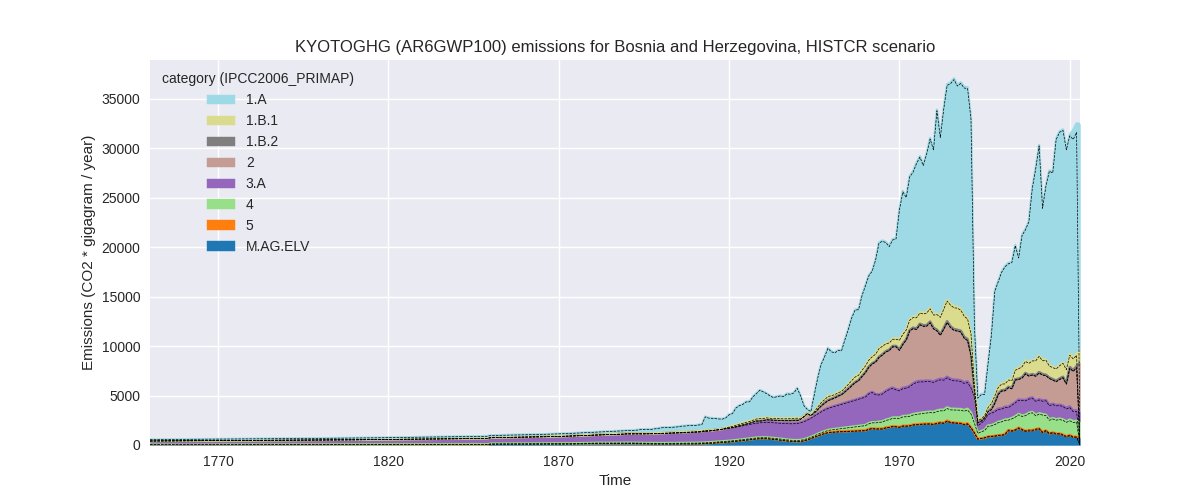
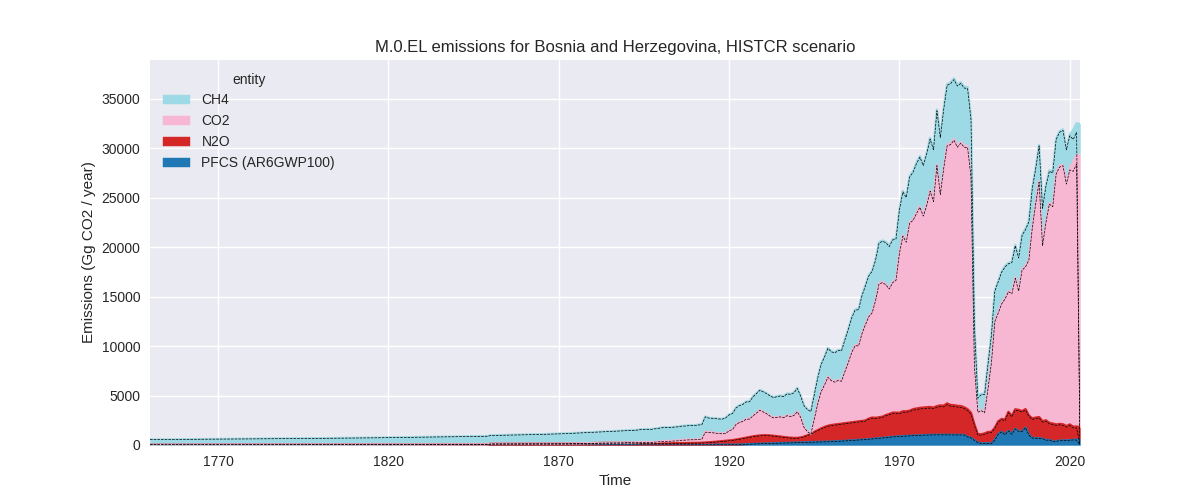
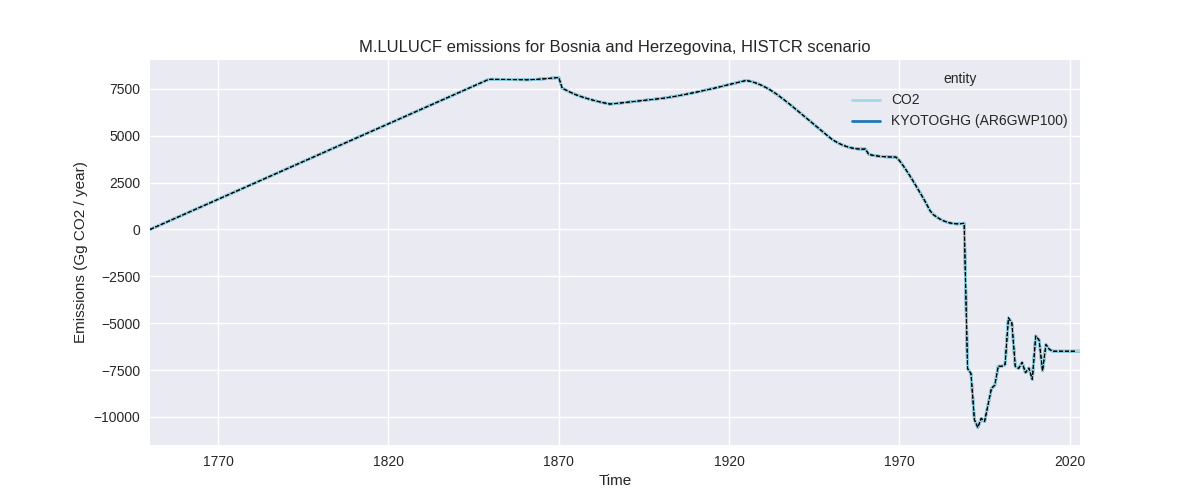
The following figures show the aggregate national total emissions excluding LULUCF AR6GWP100 for the third party priority scenario. The dotted linesshow the v2.5.1_final data.
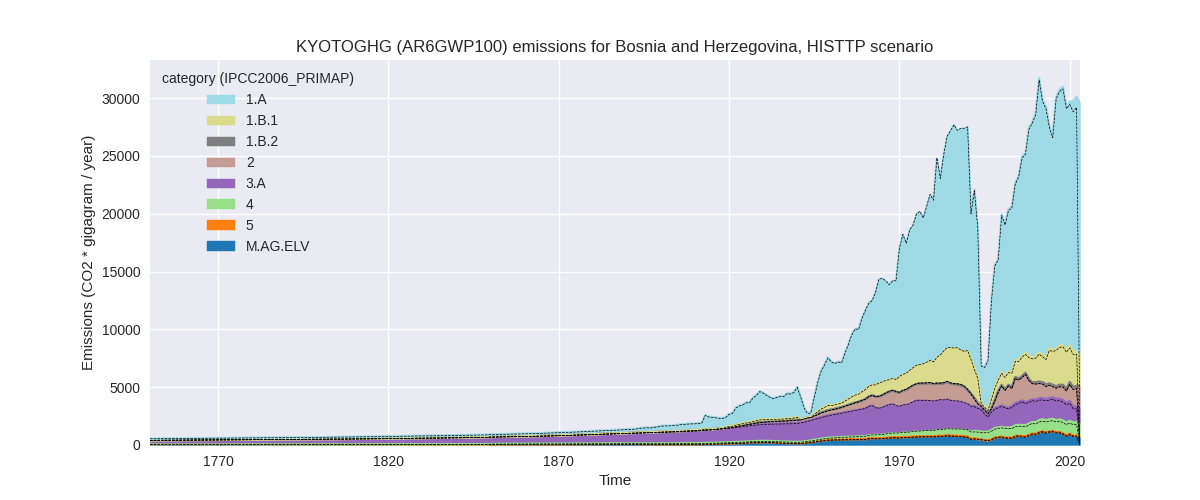


Overview over changes
In the country reported priority scenario we have the following changes for aggregate Kyoto GHG and national total emissions excluding LULUCF (M.0.EL):
- Emissions in 2022 have changed by 2.9%% (901.67 Gg CO2 / year)
- Emissions in 1990-2022 have changed by 0.6%% (139.37 Gg CO2 / year)
In the third party priority scenario we have the following changes for aggregate Kyoto GHG and national total emissions excluding LULUCF (M.0.EL):
- Emissions in 2022 have changed by 3.1%% (918.49 Gg CO2 / year)
- Emissions in 1990-2022 have changed by 0.7%% (159.86 Gg CO2 / year)
Most important changes per scenario and time frame
In the country reported priority scenario the following sector-gas combinations have the highest absolute impact on national total KyotoGHG (AR6GWP100) emissions in 2022 (top 5):
- 1: 1.A, CO2 with 745.08 Gg CO2 / year (3.3%)
- 2: 4, N2O with 92.18 Gg CO2 / year (155.3%)
- 3: 2, PFCS (AR6GWP100) with 26.40 Gg CO2 / year (5.3%)
- 4: 4, CH4 with 22.66 Gg CO2 / year (1.6%)
- 5: 5, N2O with 15.56 Gg CO2 / year (24.6%)
In the country reported priority scenario the following sector-gas combinations have the highest absolute impact on national total KyotoGHG (AR6GWP100) emissions in 1990-2022 (top 5):
- 1: 4, N2O with 84.15 Gg CO2 / year (149.8%)
- 2: 1.A, CO2 with 47.14 Gg CO2 / year (0.3%)
- 3: 5, N2O with 5.42 Gg CO2 / year (8.5%)
- 4: 4, CH4 with 1.89 Gg CO2 / year (0.2%)
- 5: 2, PFCS (AR6GWP100) with 0.80 Gg CO2 / year (0.1%)
In the third party priority scenario the following sector-gas combinations have the highest absolute impact on national total KyotoGHG (AR6GWP100) emissions in 2022 (top 5):
- 1: 1.A, CO2 with 694.76 Gg CO2 / year (3.3%)
- 2: 4, N2O with 92.18 Gg CO2 / year (155.3%)
- 3: 4, CH4 with 89.79 Gg CO2 / year (9.8%)
- 4: 2, PFCS (AR6GWP100) with 26.40 Gg CO2 / year (5.3%)
- 5: 5, N2O with 15.56 Gg CO2 / year (24.6%)
In the third party priority scenario the following sector-gas combinations have the highest absolute impact on national total KyotoGHG (AR6GWP100) emissions in 1990-2022 (top 5):
- 1: 4, N2O with 84.15 Gg CO2 / year (149.8%)
- 2: 1.A, CO2 with 43.96 Gg CO2 / year (0.3%)
- 3: 4, CH4 with 25.56 Gg CO2 / year (3.4%)
- 4: 5, N2O with 5.42 Gg CO2 / year (8.5%)
- 5: 2, PFCS (AR6GWP100) with 0.80 Gg CO2 / year (0.1%)
Notes on data changes
Here we list notes explaining important emissions changes for the country. ’' means that the following text only applies to the TP time series, while means that it only applies to the CR scenario. Otherwise the note applies to both scenarios.
- 2022 changes for energy CO2 due to updated EI data (CR, TP).
- Changes in sectors 4 and 5 are due to the removal of FAOSTAT data (CR, TP).
Changes by sector and gas
For each scenario and time frame the changes are displayed for all individual sectors and all individual gases. In the sector plot we use aggregate Kyoto GHGs in AR6GWP100. In the gas plot we usenational total emissions without LULUCF. ## country reported scenario
2022
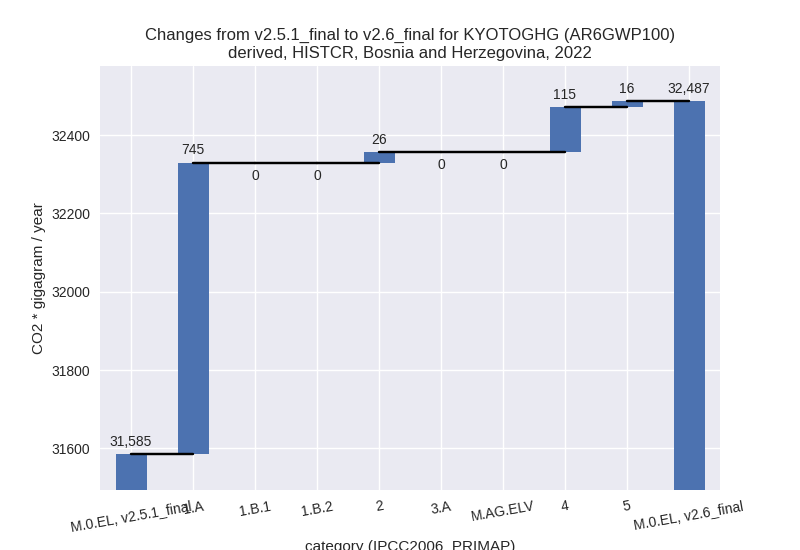
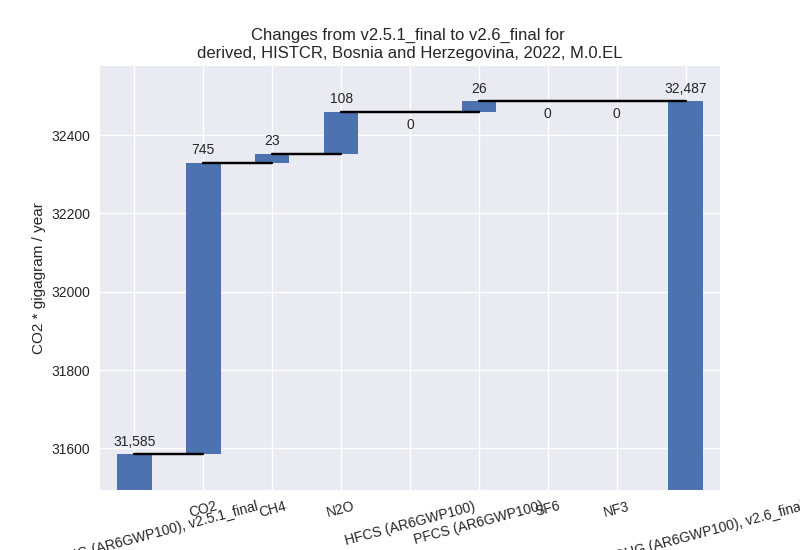
1990-2022
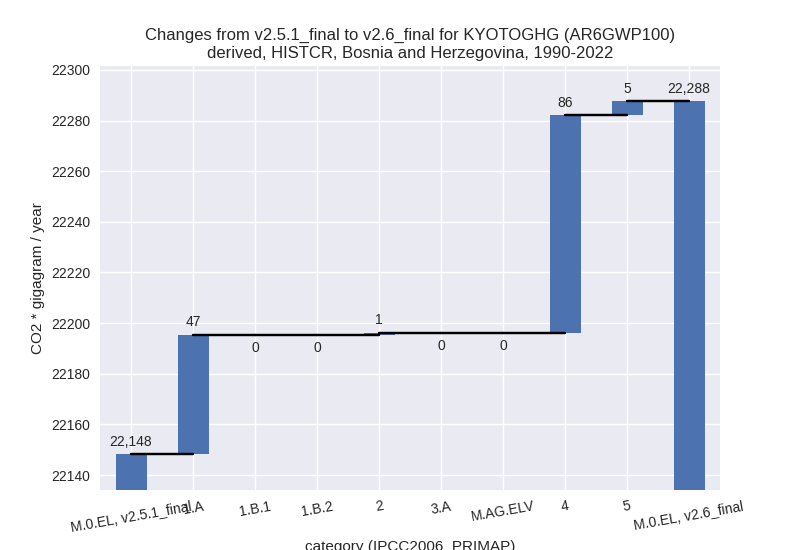
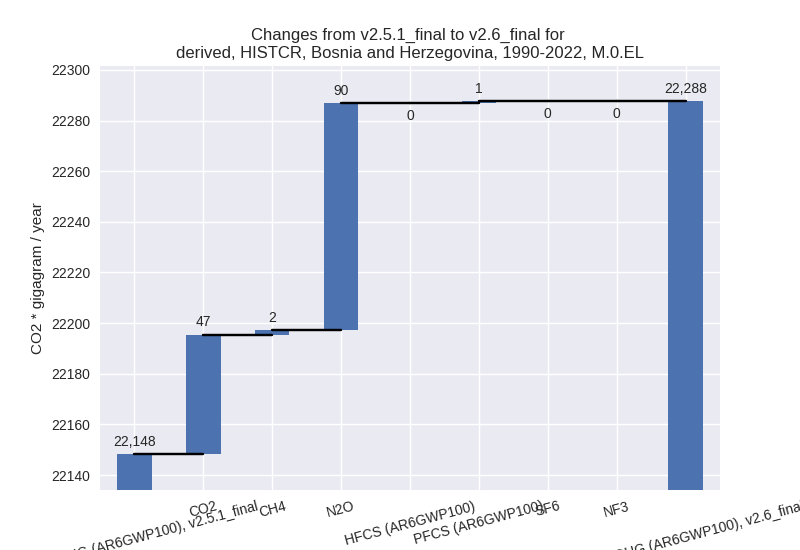
third party scenario
2022
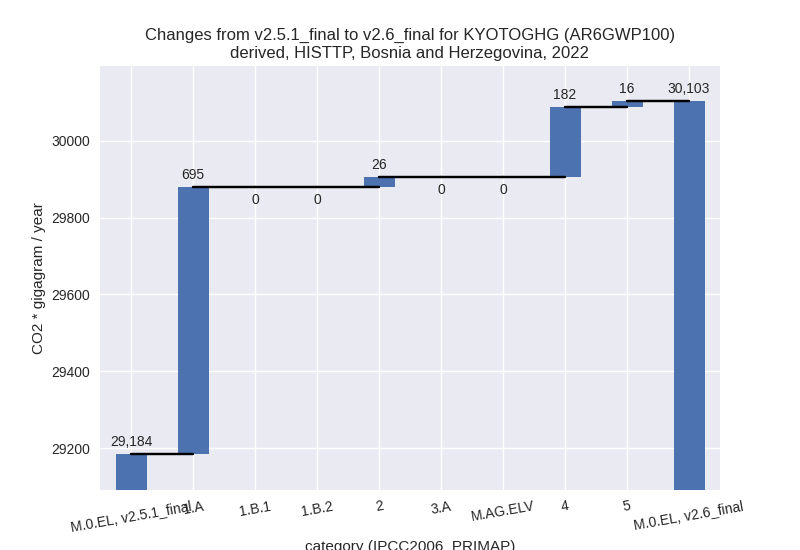
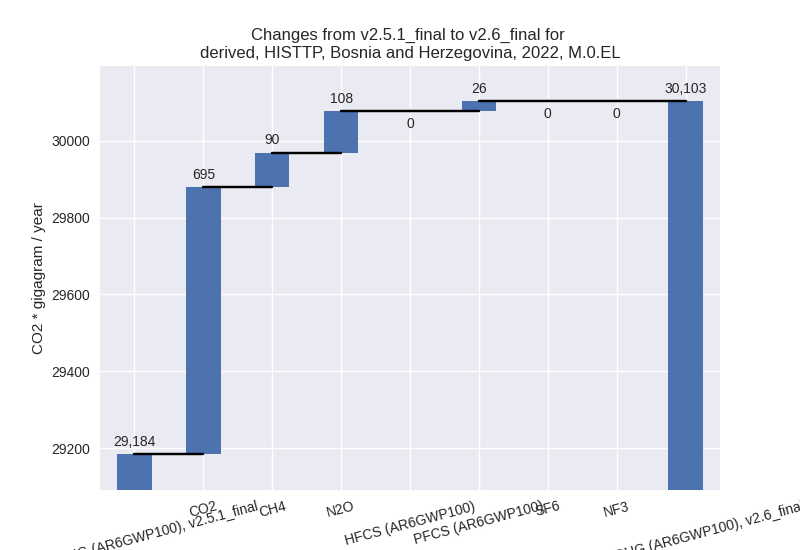
1990-2022
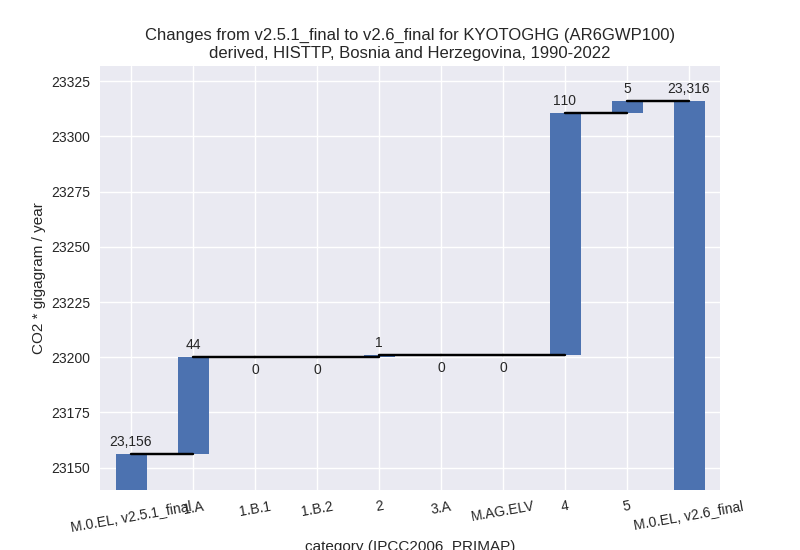
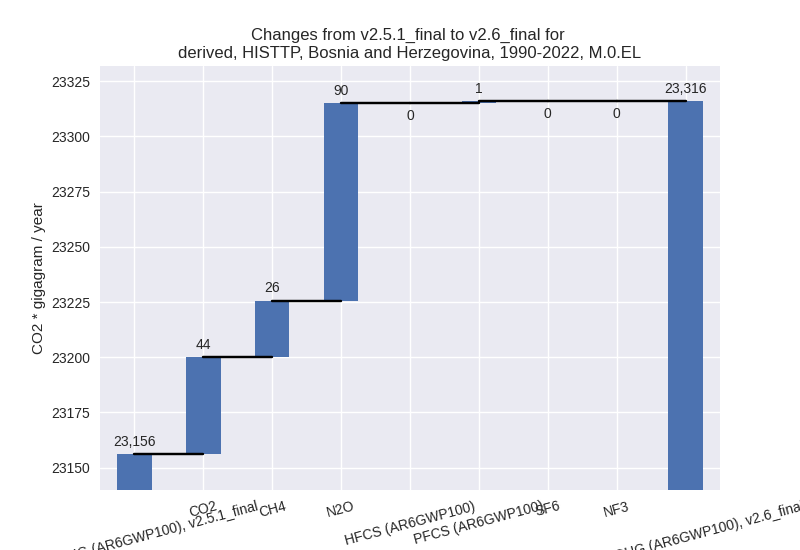
Detailed changes for the scenarios:
country reported scenario (HISTCR):
Most important changes per time frame
For 2022 the following sector-gas combinations have the highest absolute impact on national total KyotoGHG (AR6GWP100) emissions in 2022 (top 5):
- 1: 1.A, CO2 with 745.08 Gg CO2 / year (3.3%)
- 2: 4, N2O with 92.18 Gg CO2 / year (155.3%)
- 3: 2, PFCS (AR6GWP100) with 26.40 Gg CO2 / year (5.3%)
- 4: 4, CH4 with 22.66 Gg CO2 / year (1.6%)
- 5: 5, N2O with 15.56 Gg CO2 / year (24.6%)
For 1990-2022 the following sector-gas combinations have the highest absolute impact on national total KyotoGHG (AR6GWP100) emissions in 1990-2022 (top 5):
- 1: 4, N2O with 84.15 Gg CO2 / year (149.8%)
- 2: 1.A, CO2 with 47.14 Gg CO2 / year (0.3%)
- 3: 5, N2O with 5.42 Gg CO2 / year (8.5%)
- 4: 4, CH4 with 1.89 Gg CO2 / year (0.2%)
- 5: 2, PFCS (AR6GWP100) with 0.80 Gg CO2 / year (0.1%)
Changes in the main sectors for aggregate KyotoGHG (AR6GWP100) are
- 1: Total sectoral emissions in 2022 are 24535.13 Gg
CO2 / year which is 75.5% of M.0.EL emissions. 2022 Emissions have
changed by 3.1% (745.08 Gg CO2 /
year). 1990-2022 Emissions have changed by 0.3% (47.14 Gg CO2 / year). For 2022 the
changes per gas
are:

The changes come from the following subsectors:- 1.A: Total sectoral emissions in 2022 are 23273.12
Gg CO2 / year which is 94.9% of category 1 emissions. 2022 Emissions
have changed by 3.3% (745.08 Gg CO2
/ year). 1990-2022 Emissions have changed by 0.3% (47.14 Gg CO2 / year). For 2022 the
changes per gas
are:
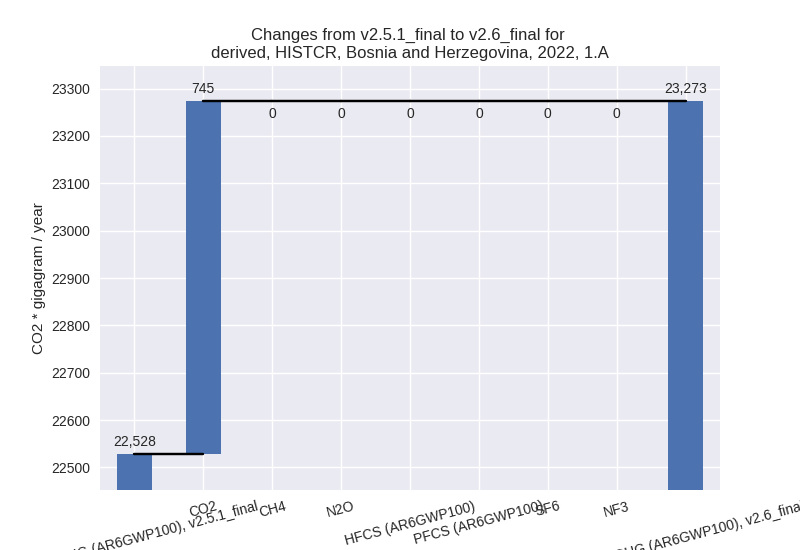
There is no subsector information available in PRIMAP-hist. - 1.B.1: Total sectoral emissions in 2022 are 1255.25 Gg CO2 / year which is 5.1% of category 1 emissions. 2022 Emissions have changed by 0.0% (0.00 Gg CO2 / year). 1990-2022 Emissions have changed by 0.0% (0.00 Gg CO2 / year).
- 1.B.2: Total sectoral emissions in 2022 are 6.76 Gg CO2 / year which is 0.0% of category 1 emissions. 2022 Emissions have changed by 0.0% (0.00 Gg CO2 / year). 1990-2022 Emissions have changed by 0.0% (0.00 Gg CO2 / year).
- 1.A: Total sectoral emissions in 2022 are 23273.12
Gg CO2 / year which is 94.9% of category 1 emissions. 2022 Emissions
have changed by 3.3% (745.08 Gg CO2
/ year). 1990-2022 Emissions have changed by 0.3% (47.14 Gg CO2 / year). For 2022 the
changes per gas
are:
- 2: Total sectoral emissions in 2022 are 4445.28 Gg CO2 / year which is 13.7% of M.0.EL emissions. 2022 Emissions have changed by 0.6% (26.40 Gg CO2 / year). 1990-2022 Emissions have changed by 0.0% (0.80 Gg CO2 / year).
- M.AG: Total sectoral emissions in 2022 are 1829.77 Gg CO2 / year which is 5.6% of M.0.EL emissions. 2022 Emissions have changed by 0.0% (0.00 Gg CO2 / year). 1990-2022 Emissions have changed by 0.0% (0.00 Gg CO2 / year).
- 4: Total sectoral emissions in 2022 are 1597.70 Gg
CO2 / year which is 4.9% of M.0.EL emissions. 2022 Emissions have
changed by 7.7% (114.64 Gg CO2 /
year). 1990-2022 Emissions have changed by 6.7% (86.02 Gg CO2 / year). For 2022 the
changes per gas
are:
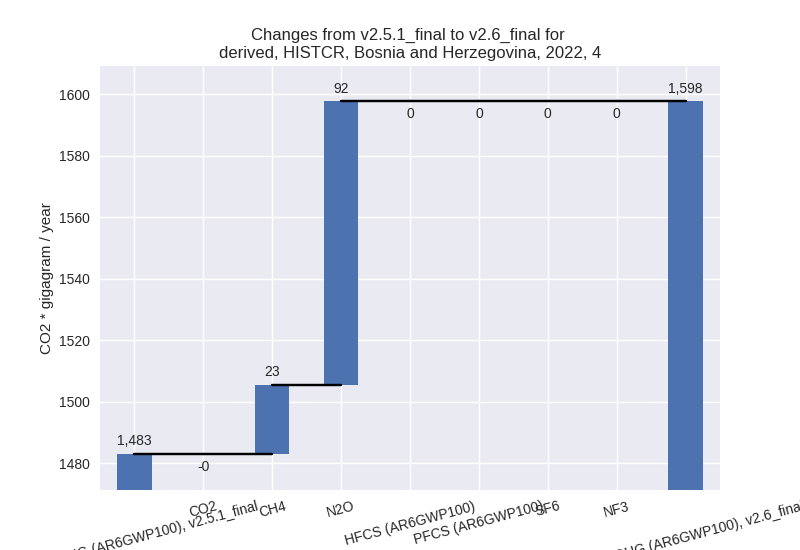
For 1990-2022 the changes per gas are:
- 5: Total sectoral emissions in 2022 are 78.75 Gg
CO2 / year which is 0.2% of M.0.EL emissions. 2022 Emissions have
changed by 24.6% (15.56 Gg CO2 /
year). 1990-2022 Emissions have changed by 8.5% (5.42 Gg CO2 / year). For 2022 the
changes per gas
are:
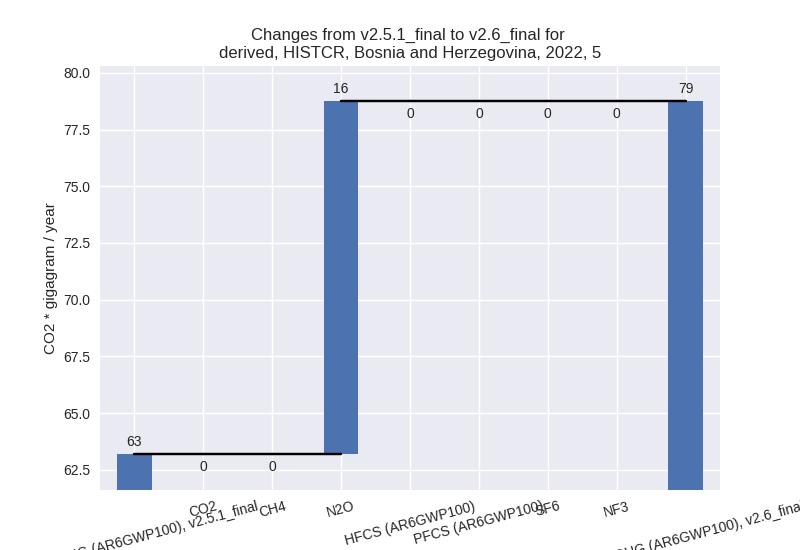
For 1990-2022 the changes per gas are:
third party scenario (HISTTP):
Most important changes per time frame
For 2022 the following sector-gas combinations have the highest absolute impact on national total KyotoGHG (AR6GWP100) emissions in 2022 (top 5):
- 1: 1.A, CO2 with 694.76 Gg CO2 / year (3.3%)
- 2: 4, N2O with 92.18 Gg CO2 / year (155.3%)
- 3: 4, CH4 with 89.79 Gg CO2 / year (9.8%)
- 4: 2, PFCS (AR6GWP100) with 26.40 Gg CO2 / year (5.3%)
- 5: 5, N2O with 15.56 Gg CO2 / year (24.6%)
For 1990-2022 the following sector-gas combinations have the highest absolute impact on national total KyotoGHG (AR6GWP100) emissions in 1990-2022 (top 5):
- 1: 4, N2O with 84.15 Gg CO2 / year (149.8%)
- 2: 1.A, CO2 with 43.96 Gg CO2 / year (0.3%)
- 3: 4, CH4 with 25.56 Gg CO2 / year (3.4%)
- 4: 5, N2O with 5.42 Gg CO2 / year (8.5%)
- 5: 2, PFCS (AR6GWP100) with 0.80 Gg CO2 / year (0.1%)
Changes in the main sectors for aggregate KyotoGHG (AR6GWP100) are
- 1: Total sectoral emissions in 2022 are 24996.45 Gg
CO2 / year which is 83.0% of M.0.EL emissions. 2022 Emissions have
changed by 2.9% (694.76 Gg CO2 /
year). 1990-2022 Emissions have changed by 0.2% (43.96 Gg CO2 / year). For 2022 the
changes per gas
are:
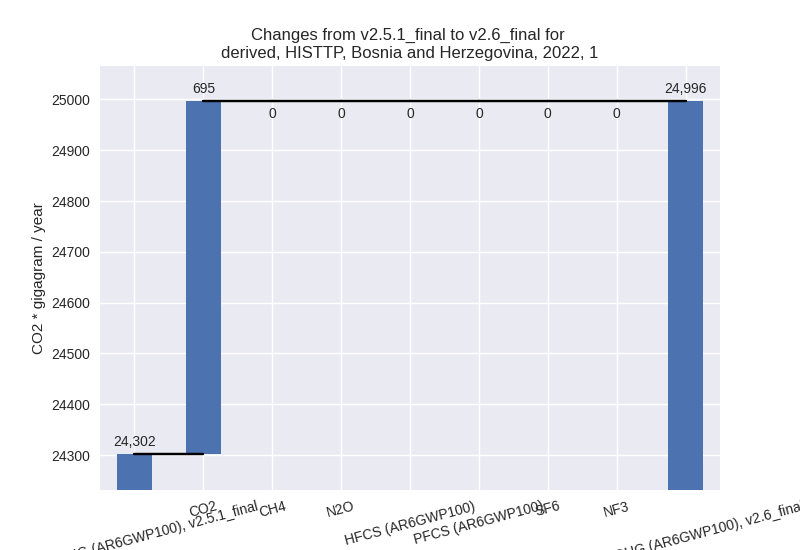
The changes come from the following subsectors:- 1.A: Total sectoral emissions in 2022 are 22026.06
Gg CO2 / year which is 88.1% of category 1 emissions. 2022 Emissions
have changed by 3.3% (694.75 Gg CO2
/ year). 1990-2022 Emissions have changed by 0.3% (43.96 Gg CO2 / year). For 2022 the
changes per gas
are:
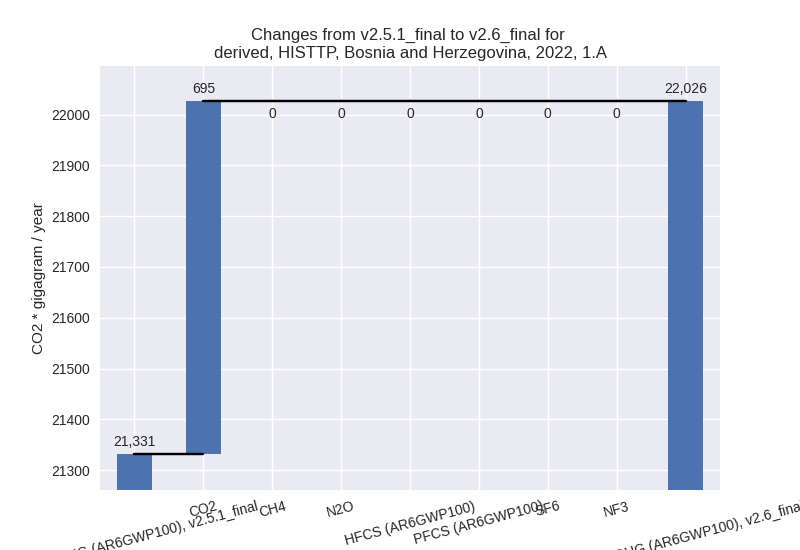
There is no subsector information available in PRIMAP-hist. - 1.B.1: Total sectoral emissions in 2022 are 2963.63 Gg CO2 / year which is 11.9% of category 1 emissions. 2022 Emissions have changed by 0.0% (0.00 Gg CO2 / year). 1990-2022 Emissions have changed by 0.0% (0.00 Gg CO2 / year).
- 1.B.2: Total sectoral emissions in 2022 are 6.76 Gg CO2 / year which is 0.0% of category 1 emissions. 2022 Emissions have changed by 0.0% (0.00 Gg CO2 / year). 1990-2022 Emissions have changed by 0.0% (0.00 Gg CO2 / year).
- 1.A: Total sectoral emissions in 2022 are 22026.06
Gg CO2 / year which is 88.1% of category 1 emissions. 2022 Emissions
have changed by 3.3% (694.75 Gg CO2
/ year). 1990-2022 Emissions have changed by 0.3% (43.96 Gg CO2 / year). For 2022 the
changes per gas
are:
- 2: Total sectoral emissions in 2022 are 1786.24 Gg CO2 / year which is 5.9% of M.0.EL emissions. 2022 Emissions have changed by 1.5% (26.40 Gg CO2 / year). 1990-2022 Emissions have changed by 0.1% (0.80 Gg CO2 / year).
- M.AG: Total sectoral emissions in 2022 are 2080.58 Gg CO2 / year which is 6.9% of M.0.EL emissions. 2022 Emissions have changed by 0.0% (0.00 Gg CO2 / year). 1990-2022 Emissions have changed by 0.0% (0.00 Gg CO2 / year).
- 4: Total sectoral emissions in 2022 are 1160.60 Gg
CO2 / year which is 3.9% of M.0.EL emissions. 2022 Emissions have
changed by 18.6% (181.78 Gg CO2 /
year). 1990-2022 Emissions have changed by 13.5% (109.69 Gg CO2 / year). For 2022 the
changes per gas
are:
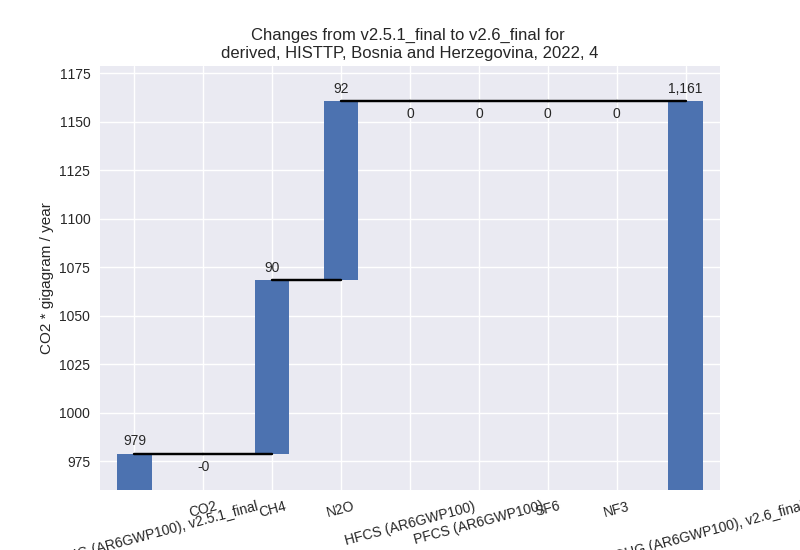
For 1990-2022 the changes per gas are: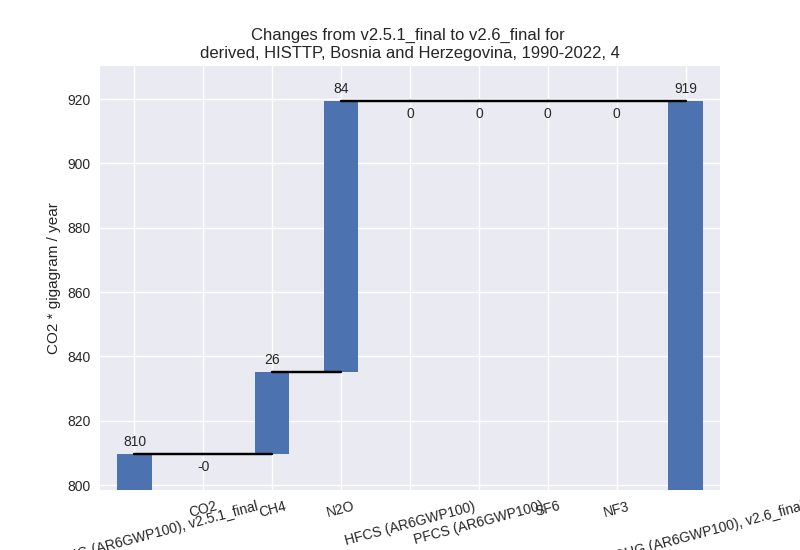
- 5: Total sectoral emissions in 2022 are 78.75 Gg
CO2 / year which is 0.3% of M.0.EL emissions. 2022 Emissions have
changed by 24.6% (15.56 Gg CO2 /
year). 1990-2022 Emissions have changed by 8.5% (5.42 Gg CO2 / year). For 2022 the
changes per gas
are:

For 1990-2022 the changes per gas are: